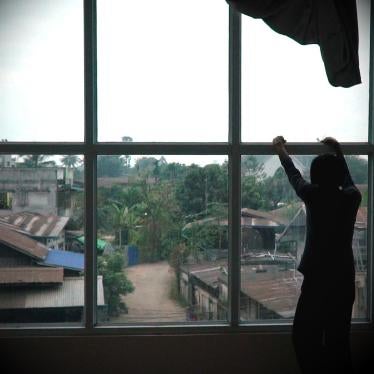(曼谷)- 人权观察今天发表报告指出,由中国资助在柬埔寨东北部兴建的一座大型水坝发电站,2018年峻工后已造成数以千计原住民与少数族裔居民的生活和生计遭受损害。这座桑河下游二级水电站是亚洲最长水坝之一,其淹没区涵盖湄公河支流桑河(Sesan)与斯瑞博河(Srepok)汇流点上游的广大地区。
这份138页的报告,《桑田沧海:一个中国“一带一路”项目对柬埔寨的人权影响》,纪录桑河下游二级水电站将大约5千人迁离祖居地所造成的经济、社会与文化权利侵害,以及上下游数万居民的生计损失。柬埔寨当局和水电公司干部并未在项目启动前适当咨询受影响社区的意见,居民的疑虑基本上受到漠视。许多水库移民失去财产和收入,却被迫接受不相称的补偿。安置区仅提供他们简陋的住房和服务,而且没有协助转换生计来源的培训或援助。水电站上下游的其他受影响社区则没有得到任何补偿或援助。
“桑河下游二级水电站彻底摧毁了原住民和少数族裔社区的生计,他们原本靠着捕鱼、森林采集和农耕,过着自给自足的集体生活,” 亚洲区倡议主任约翰・席夫顿(John Sifton)说。 “柬埔寨当局应即刻检讨该项目的补偿、安置与生计恢复办法,并确保未来其他项目不再造成同样侵害。”
人权观察访问了超过60位社区居民、公民社会领袖、学者专家及其他曾研究该项目人士,并且检阅了相关学术研究、商业纪录和非政府组织及其他来源的调研结果。
该水电站是中国政府“一带一路倡议”的一部分。“一带一路”是一项巨额投资与基础建设计划,由习近平主席于2013年启动。亚洲和其他地区的许多 “一带一路”项目都被批评缺乏透明度、漠视社区意见并可能对环境造成负面影响。
中国大型国有发电公司中国华能集团负责这座水电站的建造与运营。柬埔寨皇家集团和越南国营电力公司(EVN)持有少数股份。中国多家国有银行为该项目提供融资,据报总预算约近8亿美元。
柬埔寨政府和相关企业干部没有真正咨询受影响社区的意见,也从未依照联合国《原住民族权利宣言》求取当地原住民族的“自由、事先和知情同意”。
受到该水电站影响的原住民族和其他少数族裔包括墨侬族(Bunong)、布娄族(Brao)、归族(Kuoy)、佬族(Lao)、嘉莱族(Jarai)、客隆族(Kreung)、卡维特族(Kavet)、坦普安族(Tampuan)和卡秋族(Kachok)。
从2011年直到2018年水电站完工,社区居民不断抗议并多次致函水电公司和政府官员,包括总理洪森,但官员一再漠视社区疑虑,拒绝讨论替代方案。部分抗争人士并遭到威胁或监禁。
“公司没有考虑原住民族的权利,” 一位墨侬族村民告诉人权观察。“他们只是叫我们搬走。”
“在咨询会上,他们代我们作决定,” 一位村民表示。“他们没有征询我们的意愿或需求。”
水电站对捕渔收入有很大影响。它造成许多鱼种无法完成繁殖过程所必要的迁徙,导致渔获量急剧减少。据渔业与生态专家指出,该水电站助长整个湄公河水系的渔获量下降,危及柬埔寨、越南、泰国和老挝数千万人的食物和收入来源。
“现在鱼类非常稀少,” 一位住在水电站附近的男性居民说。“我们以前捕鱼来吃,还有多余可以出售,但[现在]全都减少了。我们有时连自己吃都不够。”
被迁移的村民表示,他们的农作收获量也因为安置区的土壤贫瘠、多石而大不如前,又失去了旧村的果树和坚果收入。政府没有补偿村民在共有林地中采集蕈类、药草和其他物资的收入损失。补偿金无法弥补原住民族的文化与生计损失。大多数安置区的井水都因污染而不能饮用。
人权观察指出,中国华能没有建立任何有效的申诉机制来解决纠纷或投诉。
数百位村民在2017年没有接受补偿或安置,而是迁往水电站创造出的水库沿岸的无主土地。他们遭到地方当局骚扰恐吓。
工程开始前,中、柬两国政府和中国华能显然都没有针对该项目的效益和影响进行有意义的评估。中国华能一再宣称该水电站年发电量可达1,998吉瓦时,约占柬埔寨全年发电量的六分之一。然而,根据该项目课税收入估计,该水电站的实际发电量可能不及它所宣称的一半。
该水电站带来的环境效益微乎其微。许多学术研究证明,水力发电厂因库区植被淹没后分解产生的碳排放,通常并不少于一般化石燃料发电厂产生的温室气体。据2017 年研究估算,该项目每兆瓦时的二氧化碳排放率与部分天然气发电厂不相上下。
人权观察分别于2020年3月和2021年5月、7月致函中、柬两国政府官员与中国华能集团,就本组织调查发现要求评论,但迄未收到任何答覆。中国华能集团于2021年5月发表有关该水电站排放量的《2020年可持续发展报告》,虽承认该水电站存在诸多问题,却淡化其严重性,并且不加明确解释即作出该项目改善水库移民生计的结论。这份报告也没有讨论水电站淹没区上下游社区受到的生计影响。
中国华能和柬埔寨政府仍有机会对该项目造成的部分伤害做出补救,特别是透过重新评估补偿方式,并为受水坝影响社区提供更多服务与培训。中国和柬埔寨政府也应该实施更有系统的改革,避免同样的侵害在其他项目重演。
“中国政府需要彻底改革‘一带一路’基础建设开发融资,以防止在柬埔寨这类政府长期剥夺人民权利的国家所进行的项目再度发生同样侵害,” 席夫顿说。“柬埔寨政府需要改革本国法律,规定所有开发项目必须做有意义的影响评估,并采取更有效的措施来预防人权迫害。”









